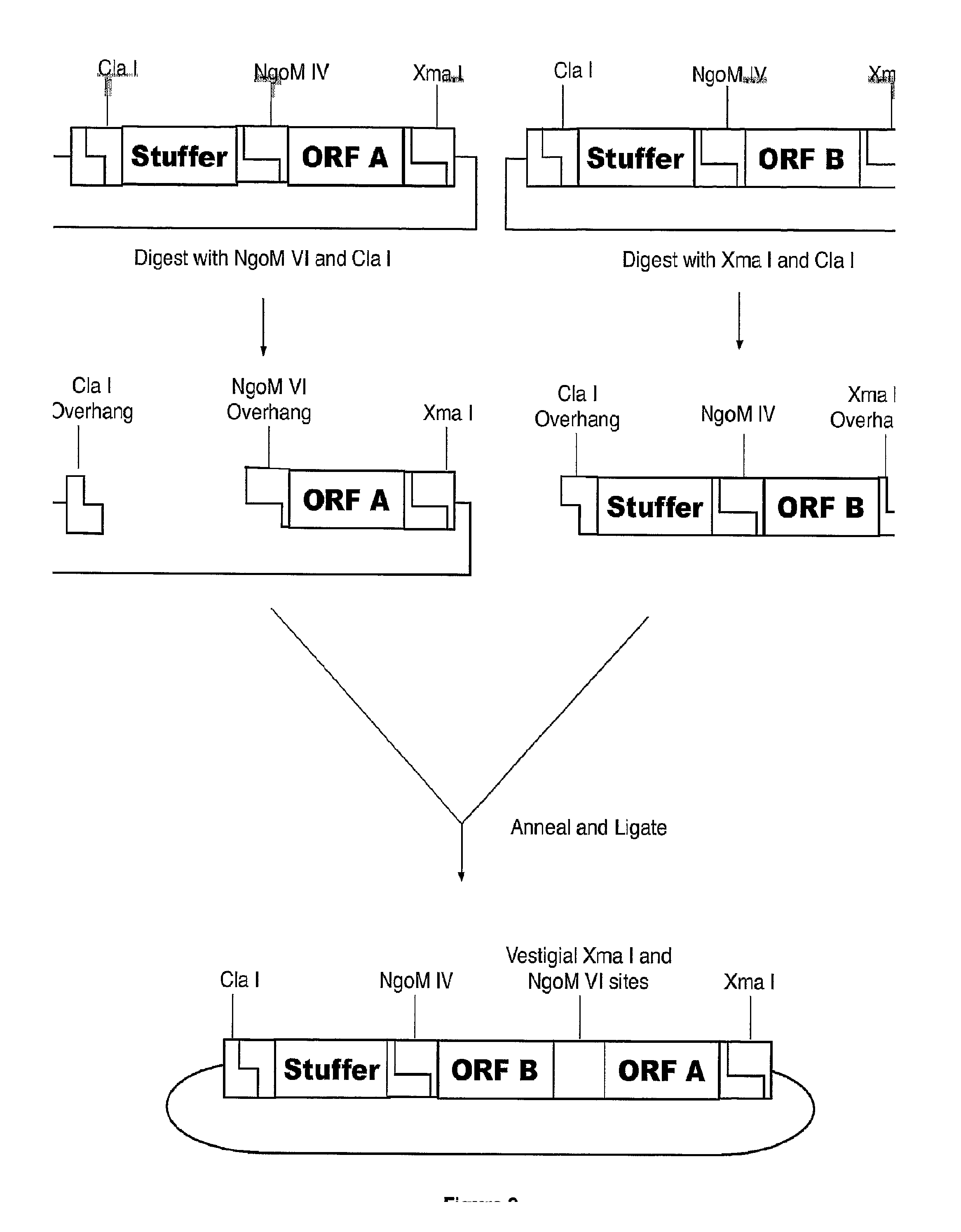Methods of Making Modular Fusion Protein Expression Products
a protein and modular technology, applied in the field of molecular biology methods and products, can solve the problem of lack of methodology for engineering chimeric protein expression products
- Summary
- Abstract
- Description
- Claims
- Application Information
AI Technical Summary
Benefits of technology
Problems solved by technology
Method used
Image
Examples
example 1
Method Starting With Two Vectors
[0038]A modular fusion protein is made using the following method and starting with 2 reagents each containing an open reading frame (ORF) of interest flanked by predetermined restriction sites. An example of restriction sites flanking an ORF of interest are sequences recognized by the restriction enzymes NgoM IV and Cla I; or Xma I and Cla I (see FIG. 1). Referring to FIG. 1, one embodiment of the method utilizes two nucleic acid starting reagents. One reagent is circular DNA containing an open reading frame of interest (ORF 1) flanked on the 5′ end by an NgoM IV site, and flanked on the 3′ end, in order, by an Xma I site and a Cla I site. In other words, a first reagent comprises DNA with the following characteristics from 5′ to 3′: - - - NgoM IV-ORF 1-Xma I-stuffer-Cla I - - - . Further referring to FIG. 1, a second reagent is circular DNA also containing an open reading frame of interest (ORF 2) flanked on the 5′ end by an NgoM IV site, and flanke...
example 2
Method Starting With One Vector
[0044]Another way to assemble coding region modules directionally and sequentially employs linear DNA in addition to circular DNA. For example, like the sequential cloning process described above, restriction sites flanking a coding region are sequences recognized by the restriction enzymes NgoM IV and Cla I; or Xma I and Cla I. Referring to FIG. 3, a first circular DNA reagent is cut with Xma I and Cla I to yield linear DNA with a 3′ Xma I overhang and a 5′ Cla I overhang. The first DNA reagent is the acceptor. A second reagent is a linear double-stranded DNA fragment generated by synthesizing and annealing complimentary oligonucleotides or by PCR amplification followed by digestion with appropriate restriction enzymes to generate overhangs. The second linear DNA has 3′ Cla I overhang and a 5′ NgoM IV overhang, which are compatible with cohesive ends of the first linearized DNA acceptor.
[0045]When these first and second DNA fragments are mixed togethe...
example 3
Method Starting With Two Linear Double-stranded DNAs
[0046]The method of the invention can also be performed with two linear DNAs as starting reagents. In this example, the NgoM IV and Xma I sites have been swapped as compared to other examples herein. Referring to FIG. 4, the two starting reagents are 1) a vector backbone with a 3′ NgoM IV overhang and a 5′ Cla I overhang, wherein an open reading frame of interest, ORF Z, is positioned upstream of the NgoM IV site and an Xma I site is positioned in frame and upstream of ORF Z, and 2) double-stranded DNA open reading frame containing a 5′ Xma I overhang and a 3′ Cla I overhang, wherein the Xma I overhang is immediately upstream and in frame with open reading frame of interest, ORF X, and wherein ORF X is followed downstream by an NgoM IV site also in frame with ORF X.
[0047]The two starting reagents may be provided or synthesized various ways. For example, by restriction endonuclease digestion, chemical synthesis, PCR amplification, t...
PUM
| Property | Measurement | Unit |
|---|---|---|
| length | aaaaa | aaaaa |
| hydrophobic | aaaaa | aaaaa |
| nucleic acid | aaaaa | aaaaa |
Abstract
Description
Claims
Application Information
 Login to View More
Login to View More - R&D
- Intellectual Property
- Life Sciences
- Materials
- Tech Scout
- Unparalleled Data Quality
- Higher Quality Content
- 60% Fewer Hallucinations
Browse by: Latest US Patents, China's latest patents, Technical Efficacy Thesaurus, Application Domain, Technology Topic, Popular Technical Reports.
© 2025 PatSnap. All rights reserved.Legal|Privacy policy|Modern Slavery Act Transparency Statement|Sitemap|About US| Contact US: help@patsnap.com



